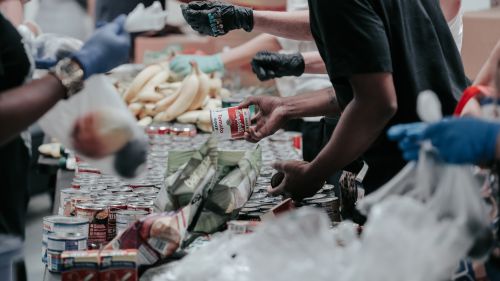Incorporating Dietary Needs and Cultural Requirements into Food Assistance Programs

Fundamental issues in food assistance programs exclude the disability community and people requiring culturally relevant foods.
Food assistance programs are an integral part of American efforts to combat food insecurity. Founded in 1939 with the original Food Stamp Program, these programs have served food insecure communities for over 80 years. However, there are fundamental issues in the design of food assistance programs, creating exclusionary policies that overlook the needs of the disability community1 and people requiring culturally relevant foods (CRFs).
During listening sessions with individuals across the country2 ahead of the September White House Conference on Hunger, Nutrition, and Health, the Chicago Council on Global Affairs and World Central Kitchen heard directly from participants about what does and does not work. Their accounts illuminated a key theme: although assistance programs increase the affordability and accessibility of food, they overwhelmingly fail to provide acceptable food. For people who have dietary restrictions due to a disability, cultural practices, or other reasons, food also needs to accommodate those dietary restrictions. For these individuals, food that accommodates dietary restrictions and cultural requirements is considered acceptable, whereas food that does not is unacceptable, regardless of whether it is affordable or accessible.
For Monica,3 a mother in Chicago, unacceptable food prohibited her from meeting her young daughter’s nutritional needs. Living with a condition that prevents her from swallowing solid food, Monica’s daughter is unable to eat most foods purchased through assistance programs. Instead, Monica must mash food into liquid by hand, an arduous task that could be eased through expansions of allowable purchases in food assistance programs (such as allowing recipients to purchase blenders, medicines, and ready-to-eat hot foods).
Monica’s story is not unique; disabled people and communities requiring CRFs reported challenges accessing acceptable food through food assistance programs. These groups experience food insecurity at a disproportionately higher rate and their needs should be considered within food assistance programs, but their concerns are nonetheless overlooked. These impediments expose deep-rooted flaws in food assistance programs that must be addressed to reduce and ultimately eliminate hunger in the United States.
Food Insecurity Is a Prominent Issue for the Disability Community
Disabled people are inordinately affected by food insecurity in the United States. In 2020, disabled adults faced food insecurity at more than double the rate of their non-disabled counterparts. Experiencing a poverty rate of 26 percent, compared to 11 percent of non-disabled people, disabled people are also at higher risk of falling into food insecurity. As a result, 26 percent of people receiving SNAP benefits also receive disability benefits, compared to only 4 percent of the US population.
When asked about their experiences with food insecurity, many listening session participants disclosed having a disability that made accessing acceptable food more difficult, including cognitive disabilities, intestinal diseases, and physical inabilities to eat food. Out of 13 focus groups, a third had at least one participant who disclosed having a disability, affirming the importance of considering the disability community’s needs in food assistance programs.
Food Assistance Barriers Prevent Equitable Access to Acceptable Food for the Disability Community
Despite the disproportionately high number of disabled people who are food insecure, food assistance programs do not adequately account for their needs. Some participants, like Monica, felt as though “[food assistance] programs have forgotten about mothers like me, with kids that have special eating needs, and how difficult and complicated it can be to figure out trying to put together a meal.”
Richard, an Oakland Supplemental Nutrition Assistance Program (SNAP) recipient, shared a similar experience of alienation and lack of acceptable food. Unable to cook for himself due to a cognitive disability, Richard used his SNAP benefits to purchase frozen meals, but felt stuck in a “poverty trap” that sacrifices his social status and pride. Like many other listening session participants, Richard wished SNAP and other food assistance programs would allow people to purchase food at restaurants because “it feels a little more dignified sometimes.”
Beyond limited access to acceptable food, food assistance programs do not always create systems that are navigable for all disabled people. Application and enrollment processes require extensive paperwork and interviews, creating unnecessary barriers. Some people with disabilities, like Sean from Chicago, felt as though they “have to strive to push hard enough to go get those resources, because they’re not going to walk to us…you just have to search and get it.”
Limited definitions of what qualifies as a disability similarly disincentivize disabled people from applying for programs. SNAP and the Illinois Link Program (Link) require that people receive some form of government disability payments in order to qualify as disabled, creating an entirely separate certification process that necessitates additional paperwork and interviews. This puts an undue burden on disabled people to prove their disability status, creating additional barriers to qualifying for food assistance programs.
Communities Requiring CRFs Experience Increased Rates of Food Insecurity
Similar to the disability community, people who need CRFs experience increased rates of food insecurity. Defined as foods that hold significance for a particular cultural or ethnic group, CRFs are not readily available in food assistance programs, creating barriers to accessing acceptable food. Minoritized and non-English speaking populations, specifically, are less likely to find food that meets their cultural needs and face food insecurity at a rate 50 percent higher than the average American. These populations also struggle to maximize benefits of the programs, as they are not given knowledge on how to prepare and cook food provided through government food assistance programs, which exacerbates existing inequities and fuels food insecurity. Their inability to access CRFs also creates cultural divides that can contribute to social isolation and undernourishment; food may be available, but it is not acceptable. According to Selma listening session participant Joanne, “Food is about nutrition, but it’s also about…more than just what makes me full.”
Food Assistance Barriers Prevent Equitable Access to CRFs
Irene, a Chicago mother of three who recently moved from Brazil, explained that she has “a lot of difficulties finding good food for ourselves and food that will be for our taste.” Like many people with minoritized cultural backgrounds, Irene struggled to find food that she knew how to prepare, forcing her to find pre-made meals from food kitchens or frozen meals at grocery stores. Despite reaching out for help, language barriers create additional hurdles that prevented Irene and her family from accessing acceptable food, making their biggest problem “being able to just eat the food here.”
Participants from Oakland experienced similar barriers to finding CRFs. Jacqueline often found herself in situations where “all the ingredients are so different,” leaving her unable to use benefits from SNAP or the Special Supplemental Nutrition Program for Women, Infants, and Children (WIC). Owen encountered the same problem, calling government food assistance “one-size-fits-all, cookie-cutter programs” that do not address cultural diversity. Beyond their inability to find CRFs, participants described reaching out for help as a tumultuous and nearly always unhelpful process. Some participants like Trevor, from Oakland, felt that “you are not entitled to even ask for [culturally relevant foods] and you should feel ashamed, or at least get on your knees and beg for it.”
Community-Based Organizations Are Better Prepared to Address Food Insecurity
Although disabled people and minoritized communities requiring CRFs cannot always access acceptable food through government assistance programs, listening session participants noted that community-based organizations (CBOs) are significantly more successful in meeting their needs. Alex, an Oaklander, described food from the CBO Homies Empowerment as “excellent” and “helpful,” which ultimately “allow us to survive.” Participants in Selma and Chicago provided similar feedback, lauding CBOs for their excellent attention to the community members’ needs.
Listening session participants repeatedly stated that food assistance programs provide much needed aid, but not to all people; disabled people and communities requiring CRFs continue to fall through the cracks. In order to alleviate hunger in the United States, listening session participants stated that they need food assistance programs like SNAP, WIC, and Link to take note of how CBOs provide personalized, acceptable food that accounts for diverse needs.
Hunger continues to pervade disabled and minoritized communities because of ableist, culturally selective policies that make it difficult for people to access the food they need. Food assistance programs have an opportunity to better serve the people they intend to reach by taking dietary needs and cultural requirements into consideration.
- 1Identity-first language prioritizes disability identities, in contrast to person-first language that puts personhood before identity. In using candid and less euphemistic terms, identity-first language emphasizes how disabilities are an edifying and meaningful part of a person’s life, rather than something to be ashamed of. Although preferences among the disability community vary and there is no singular stance on whether to use identity- or person-first language, this blog prioritizes identity-first language to illuminate and recognize the pride in the disability identity. Learn more about the difference between identity- and person-first language.
- 2The Chicago Council on Global Affairs’ Center on Global Food and Agriculture and World Central Kitchen hosted listening sessions in Chicago, IL, Oakland, CA, and Selma, AL.
- 3All names have been changed to protect the identity of listening session participants.

